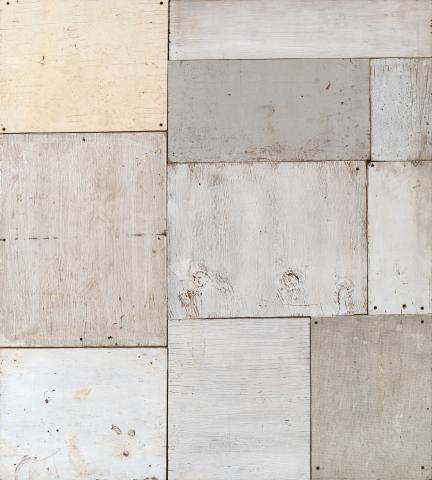COMPOUND, 1994
ROSALIE GASCOIGNE
painted wood, composition board and plywood on composition board
102.5 x 92.5 cm
signed, dated and inscribed verso: Rosalie Gascoigne / 1994 / ‘COMPOUND’
Roslyn Oxley9 Gallery, Sydney (label attached verso)
Private collection, New South Wales
Rosalie Gascoigne, Roslyn Oxley9 Gallery, Sydney, 6 – 30 April 1994, cat. 8
MacDonald, V., Rosalie Gascoigne, Regaro, Sydney, 1997, pl. 62, p. 99 (illus. and back cover, detail)
Compound, 1994, is a lyrical narrative of the Australian landscape composed of whites and creams, taupe and grey, faded colours which Rosalie Gascoigne held so dear towards the end of her career. These weathered rectangular blocks of industrial wood are arranged in a stacked composition that draws our eyes to the convergence of blocks in the upper right-hand corner. This pale and ethereal composition is a compelling example of Gascoigne’s abiding interest in the expansive Australian sky, the hues and atmospheres of which she found difficult to pin down. Of this painting, the artist herself said ‘I was doing air – it’s very hard to make air – have you ever tried to make air? It’s very, very difficult’.1
Gascoigne’s work built upon many decades of visual attentiveness to the landscape around her isolated home, at Mt Stromlo, near Weston Creek in the Australian Capital Territory. She was uniquely receptive to instances of the sublime in the industrial artefacts found in the Australian bush. In presenting Australian and international audiences with these abstracted fragments, Gascoigne’s fresh approach transformed our understanding of sculptural assemblage and the depiction of Australian landscape in contemporary art.
Gascoigne’s works evoke the intangible effects of the Australian landscape: sensations, memories and atmosphere. By scavenging and reinventing what Gascoigne called ‘flotsam and jetsam’2, she shone a light not on the materials themselves, but on their worn and patinated surfaces. The strength of Gascoigne’s art lies within these palimpsests, proof of the time the objects spent within the landscape. The uneven erosion of these materials is presented modestly to the viewer, highlighted by the regularity of Gascoigne’s typically orthogonal compositions.
‘Second hand materials aren’t deliberate; they have had sun and wind on them. Simple things. From simplicity you get profundity’.3
The depth of Gascoigne’s interaction with her physical surroundings allowed her to transcend local sensibility, connecting her to a larger sense of place, felt by people around the world. She firmly believed in the universal language of art. While Gascoigne’s aesthetic was primarily formal and abstract, her approach to art-making was intuitive. She was an autodidact, and while well-read, her practice was informed only by her passion for Ikebana, the ancient Japanese art of flower arrangement.
Gascoigne rose quickly to critical acclaim during the 1970s, and became one of Australia’s most revered artists working in the field of sculptural assemblage. Her artistic practice remained remarkably down-to-earth, her works developing organically through the careful arrangement and reinvention of natural and manmade materials. Gascoigne often described her own work as ‘stammering concrete poetry’4, and even when devoid of text (which Gascoigne considered secondary to line and colour), they contain within their composition a sense of harmony and rhythm that is undeniably poetic.
1. Gascoigne, R., cited in MacDonald, V., Rosalie Gascoigne, Regaro, Sydney, 1997, p. 99
2. Hughes, R., interview for the Australian Biography Project, 12 November 1998, tape 5
3. Gascoigne, R., cited in Edwards, D., Rosalie Gascoigne: Material as Landscape, Trustees of the Art Gallery of New South Wales, Sydney, 1998, p. 11
4. O'Brien G., ‘Plain air / plain song’, in Rosalie Gascoigne: Plain Air, City Gallery Wellington and Victoria University Press, Wellington, 2004, p. 42
LUCIE REEVES-SMITH
